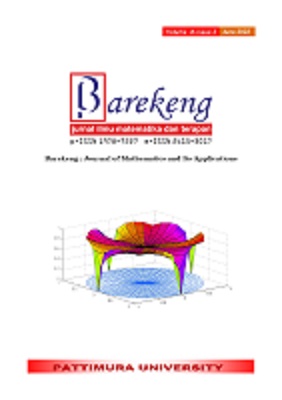APPLICATION OF SYSTEM MAX-PLUS LINEAR EQUATIONS ON SERIAL MANUFACTURING MACHINE WITH STORAGE UNIT
Abstract
The set together with the operation maximum (max) denoted as and addition (+) denoted as is called max-plus algebra. Max-plus algebra may be used to apply algebraically a few programs of Discrete Event Systems (DES), certainly one of the examples in the production system. In this study, the application of max-plus algebra in a serial manufacturing machine with a storage unit is discussed. The results of this are the generalization system max-plus-linear equations on a production system that is, in addition, noted the max-plus-linear time-invariant system. From the max-plus-linear time-invariant system, it can be obtained the equation which is then used to determine the beginning time of a production system so the manufacturing machine work periodically. The eigenvector and eigenvalue of the matrix are then used to find the beginning time and the period time of the manufacturing machine. Furthermore, the time when the product leaves the manufacturing machine with the time while the raw material enters the manufacturing machine is given and vice versa are obtained from the max-plus-linear time-invariant system that is can be formed in the equation .
Downloads
References
S. Van Loenhout, T. Van Den Boom, S. Farahani, and B. De Schutter, “Model Predictive Control for Stochastic Switching Max-Plus-Linear Systems,” IFAC Proc. Vol., vol. 45, no. 29, pp. 79–84, 2012, doi: 10.3182/20121003-3-MX-4033.00016.
J. Komenda, S. Lahaye, J. L. Boimond, and T. van den Boom, “Max-Plus Algebra and Discrete Event Systems,” IFAC-PapersOnLine, vol. 50, no. 1, pp. 1784–1790, 2017, doi: 10.1016/j.ifacol.2017.08.163.
A. Permana, S. Siswanto, and P. Pangadi, “Eigen Problem Over Max-Plus Algebra on Determination of the T3 Brand Shuttlecock Production Schedule,” Numer. J. Mat. dan Pendidik. Mat., vol. 4, no. 1, pp. 23–30, 2020, doi: 10.25217/numerical.v4i1.702.
B. De Schutter, T. van den Boom, J. Xu, and S. S. Farahani, “Analysis and Control of Max-Plus Linear Discrete-Event Systems: An Introduction,” Discret. Event Dyn. Syst. Theory Appl., vol. 30, no. 1, pp. 25–54, 2020, doi: 10.1007/s10626-019-00294-w.
A. Kurniawan, A. R. I. Suparwanto, and A. Max-plus, “Sistem Persamaan Linear Max-Plus dan Terapannya pada Sistem Jaringan Kereta Api,” J. Mat. Thales, vol. 02, no. 01, pp. 63–77, 2020.
T. J. J. Van Den Boom and B. De Schutter, “Modeling and Control of Switching Max-Plus-Linear Systems with Random and Deterministic Switching,” Discret. Event Dyn. Syst. Theory Appl., vol. 22, no. 3, pp. 293–332, 2012, doi: 10.1007/s10626-011-0123-x.
T. J. J. van den Boom, M. van den Muijsenberg, and B. De Schutter, “Model Predictive Scheduling of Semi-Cyclic Discrete-Event Systems Using Switching Max-Plus Linear Models and Dynamic Graphs,” Discret. Event Dyn. Syst. Theory Appl., vol. 30, no. 4, pp. 635–669, 2020, doi: 10.1007/s10626-020-00318-w.
B. de Schutter, “Max-Algebraic System Theory for Discrete Event Systems,” Katholieke Universiteit Leuven, 1996.
Subiono, Aljabar Maxplus dan Terapannya, 2.0.0. Surabaya: Institut Teknologi Sepuluh Nopember, 2014.
M. D. Van Den Muijsenberg, “Scheduling Using Max-Plus Algebra General Framework and Application to A Baggage Handling System,” Delft University of Technology, 2015.
S. Siswanto, “Permanen dan Dominan Suatu Matriks Atas Aljabar Max-Plus Interval,” PYTHAGORAS, vol. 7, no. 2, pp. 45–54, 2012.
D. Adzkiya, B. De Schutter, and A. Abate, “Backward Reachability of Autonomous Max-Plus-Linear Systems,” IFAC Proc. Vol., vol. 9, no. 3, pp. 117–122, 2014, doi: 10.3182/20140514-3-FR-4046.00056.
A. Abate, A. Cimatti, A. Micheli, and M. S. Mufid, “Computation of The Transient in Max-Plus Linear Systems via SMT-Solving,” Lect. Notes Comput. Sci. (including Subser. Lect. Notes Artif. Intell. Lect. Notes Bioinformatics), vol. 12288 LNCS, pp. 161–177, 2020, doi: 10.1007/978-3-030-57628-8_10.
M. Umer, U. Hayat, and F. Abbas, “An Efficient Algorithm for Nontrivial Eigenvectors in Max-Plus Algebra,” Symmetry (Basel)., vol. 11, no. 6, pp. 1–9, 2019, doi: 10.3390/sym11060738.
L. Aulia and R. H. Tjahjana, “Predictive Control for Max-Plus Linear Systems in Production Systems,” J. Fundam. Math. Appl., vol. 3, no. 2, pp. 133–147, 2020.
L. Wang, W. Li, and H. Li, “AE Solutions to Two-Sided Interval Linear Systems Over Max-Plus Algebra,” J. Inequalities Appl., vol. 291, pp. 1–13, 2018, doi: 10.1186/s13660-018-1869-6.
C. Wang and Y. Tao, “A Note on Global Optimization for Max-Plus Linear Systems,” Automatica, vol. 119, p. 109104, 2021.
J. Xu, B. De Schutter, and T. J. J. Van Den Boom, “Model Predictive Control for Max-Plus-Linear Systems via Optimistic Optimization,” IFAC Proc. Vol., vol. 9, no. 3, pp. 111–116, 2014, doi: 10.3182/20140514-3-FR-4046.00063.
Authors who publish with this Journal agree to the following terms:
- Author retain copyright and grant the journal right of first publication with the work simultaneously licensed under a creative commons attribution license that allow others to share the work within an acknowledgement of the work’s authorship and initial publication of this journal.
- Authors are able to enter into separate, additional contractual arrangement for the non-exclusive distribution of the journal’s published version of the work (e.g. acknowledgement of its initial publication in this journal).
- Authors are permitted and encouraged to post their work online (e.g. in institutional repositories or on their websites) prior to and during the submission process, as it can lead to productive exchanges, as well as earlier and greater citation of published works.






1.gif)



